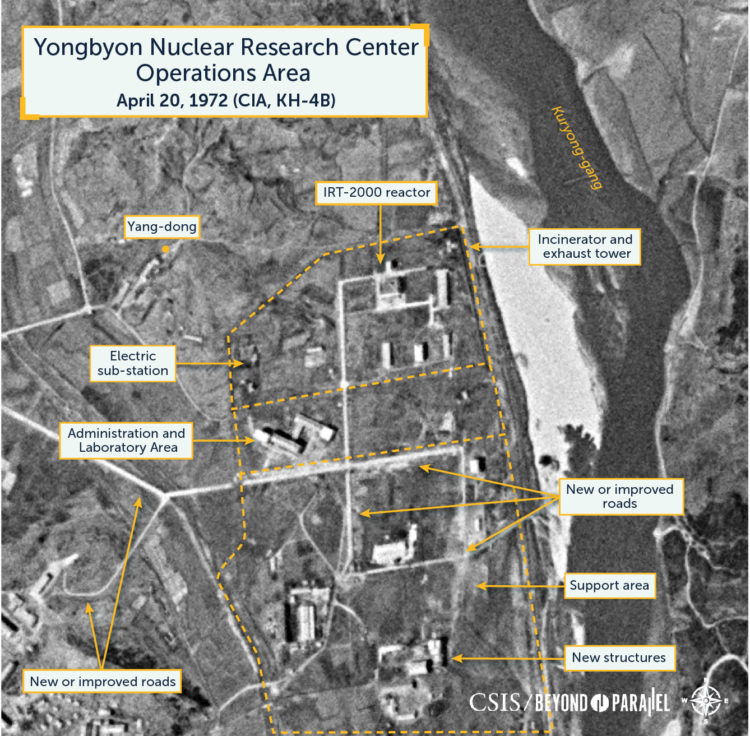
Yongbyon Declassified Part VII: Final Stretch of First-Phase Construction Begins
KH-4B Mission 1116, April 20, 1972
Collected approximately 2 years after the image provided in Yongbyon Declassified Part VI (March 17, 1970) this April 20, 1972 KH-4B image represents one of the last clear declassified images collected by the KH-4 systems of the Yongbyon Nuclear Research Center. The KH-4 systems (-4/-4A/-4B) were operational from February 1962 until May 1972 and were superseded by the KH-9 systems, which were operational from June 1971 to April 1986.1 The KH-9 imagery will be the focus of future installments of Yongbyon Declassified.

The April 20, 1972 KH-4B image shows significant expansion within the village of Sang-dong, minor infrastructure development within the operations, administration/laboratory and support areas, and continuing construction on the bridge across the Kuryong-gang and its access roads. Taken as a whole, these developments continue to represent both an ongoing first-phase construction project for the facility and early infrastructure development efforts within a longer-term plan for future expansion. This work laid the foundations for the construction of the facility’s first waste storage facility (on the east side of the Kuryong-gang) in the years to follow and the massive second phase expansion that would begin during the early-1980s.

Within the town of Sang-dong construction has continued at a steady pace. At the center of the town what appear to be security and barracks buildings (identified by the large parade ground) have been completed. The construction of additional buildings is also observed in the east and southeast sections of the town. A number of the perimeter roads have been surfaced and new roads have been built leading to the operations (IRT-2000 reactor), administration/laboratory and Yang-dong areas. Additional minor changes are noted along the southern outskirts among the town’s older and smaller structures.

Aside from the new road leading from Sang-dong several roads have been improved or newly built within the operations and administration/laboratory areas. These new and improved roads have also been extended south into the support area. No observable changes are noted to the IRT-2000 reactor building, associated support buildings or the electric sub-station.

Within the support area, immediately north of Pungang-ni, several new structures have been added to a small compound. Given this compound’s layout and its development it is likely that it is agriculture-related. However, it is just as likely that it operates in support of the research center and organizations within Sang-dong. Work continues on the road bridge across the Kuryong-gang and the piers and deck have been completed. While it is likely some occasional traffic crosses the bridge, the continued work on the access roads suggests that this project is neither complete nor is the bridge fully operational. The road leading north and east to the town of Yongbyon appears to have been improved and portions of the road leading south, through the future sites of the Radiochemistry Laboratory and 50MWe reactor, have also been improved. There are still no indications in the imagery that work has begun on the future road tunnel on the east bank of the bridge.

No changes of significance are noted at the precast concrete plant southwest of Pungang-ni. With one exception this is also true for the area southeast of the bridge that will house the future Radiochemistry Laboratory, 50MWe reactor, fuel fabrication, centrifuge and other related facilities. The one exception is the road leading south from the bridge noted above. A small loop has been added to this road north of the future location “Building 500” although there are no indications of it being directly related to the future facility.

References
- During the period in which the KH-4 systems were operational (1962-1972) there were three additional optical satellite reconnaissance systems in operation—the KH-5, KH-6 and KH-7. The KH-5 program ran from May 1962 to August 1964 and had a resolution of approximately 460 feet. Because of its low resolution none of these images were considered for this survey. The KH-6 program was an unsuccessful program that ran from only July 1963 to August 1963 and had a resolution of approximately 6 feet. None of these images were considered for this survey. The KH-7 system was operational from July 1963 to June 1967 and had a resolution of 2 to 4 feet. Unfortunately, not all images have been released or those readily available do not cover the Yongbyon Nuclear Research Center. The KH-9 systems were operational from June 1971 to April 1986 and collected both high-resolution (2-4 feet) and moderate-resolution (20-30 feet) images. ↩
